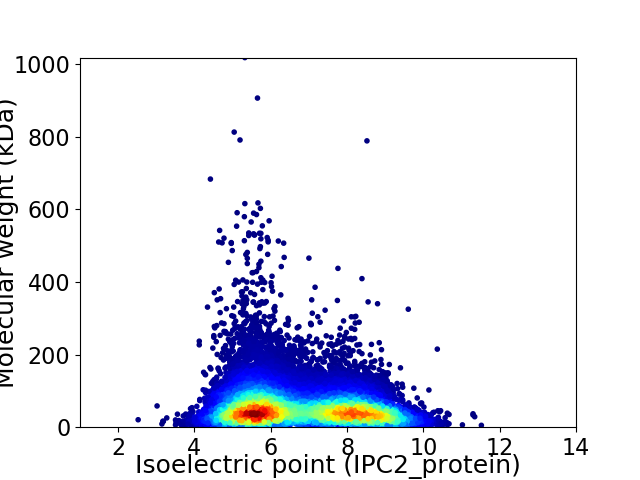
Anolis carolinensis (Green anole) (American chameleon)
Taxonomy: cellular organisms; Eukaryota; Opisthokonta; Metazoa; Eumetazoa; Bilateria; Deuterostomia; Chordata; Craniata; Vertebrata; Gnathostomata; Teleostomi; Euteleostomi; Sarcopterygii; Dipnotetrapodomorpha; Tetrapoda; Amniota; Sauropsida; Sauria; Lepidosauria; Squamata;
Average proteome isoelectric point is 6.75
Get precalculated fractions of proteins

Virtual 2D-PAGE plot for 19108 proteins (isoelectric point calculated using IPC2_protein)
Get csv file with sequences according to given criteria:
* You can choose from 21 different methods for calculating isoelectric point
Summary statistics related to proteome-wise predictions



Protein with the lowest isoelectric point:
>tr|G1KNL6|G1KNL6_ANOCA Uncharacterized protein OS=Anolis carolinensis OX=28377 PE=4 SV=1
LL1 pKa = 7.34TDD3 pKa = 3.72TEE5 pKa = 4.64VDD7 pKa = 3.43TEE9 pKa = 4.22KK10 pKa = 10.93NQNVEE15 pKa = 4.4GSSSTLEE22 pKa = 4.19LLSDD26 pKa = 3.93IPFTLAPHH34 pKa = 5.9VLAVQDD40 pKa = 3.57TCNDD44 pKa = 3.81FSRR47 pKa = 11.84HH48 pKa = 5.63LLSCDD53 pKa = 3.21VNDD56 pKa = 3.34NLTRR60 pKa = 11.84FWYY63 pKa = 10.18DD64 pKa = 3.17FTLEE68 pKa = 3.96NSVLCEE74 pKa = 3.99SS75 pKa = 4.17
LL1 pKa = 7.34TDD3 pKa = 3.72TEE5 pKa = 4.64VDD7 pKa = 3.43TEE9 pKa = 4.22KK10 pKa = 10.93NQNVEE15 pKa = 4.4GSSSTLEE22 pKa = 4.19LLSDD26 pKa = 3.93IPFTLAPHH34 pKa = 5.9VLAVQDD40 pKa = 3.57TCNDD44 pKa = 3.81FSRR47 pKa = 11.84HH48 pKa = 5.63LLSCDD53 pKa = 3.21VNDD56 pKa = 3.34NLTRR60 pKa = 11.84FWYY63 pKa = 10.18DD64 pKa = 3.17FTLEE68 pKa = 3.96NSVLCEE74 pKa = 3.99SS75 pKa = 4.17
Molecular weight: 8.47 kDa
Isoelectric point according different methods:
Protein with the highest isoelectric point:
>tr|H9GUU8|H9GUU8_ANOCA Protein kinase domain-containing protein OS=Anolis carolinensis OX=28377 GN=LOC103282236 PE=3 SV=1
AA1 pKa = 7.6SPSAQGSILRR11 pKa = 11.84TLTTQPSTAKK21 pKa = 10.31ASPSAQGSILRR32 pKa = 11.84TLTTQPFNAQASPSAQGSILRR53 pKa = 11.84TLTTQPSNAKK63 pKa = 9.96ASPSAQGSILRR74 pKa = 11.84TLTTQPFNAQASPSAQGSILRR95 pKa = 11.84PLTTQPFNAKK105 pKa = 9.92ASPSAQGSILRR116 pKa = 11.84PLTTQPFNAKK126 pKa = 9.92ASPSAQGSVLRR137 pKa = 11.84PLTTQPFNAKK147 pKa = 9.92ASPSAQGSGSILRR160 pKa = 11.84PLTTQPFNAKK170 pKa = 9.92ASPSAQGSILRR181 pKa = 11.84PLTTQPFNAKK191 pKa = 9.92ASPSAQGSILRR202 pKa = 11.84PLTTQPFNAKK212 pKa = 9.92ASPSAQGSVLRR223 pKa = 11.84PLTTQPFNAKK233 pKa = 9.92ASPSAQGSILRR244 pKa = 11.84PLTTQPFNAKK254 pKa = 9.92ASPSAQGSVLRR265 pKa = 11.84PLTTQPFNAKK275 pKa = 9.92ASPSAQGSS283 pKa = 3.61
AA1 pKa = 7.6SPSAQGSILRR11 pKa = 11.84TLTTQPSTAKK21 pKa = 10.31ASPSAQGSILRR32 pKa = 11.84TLTTQPFNAQASPSAQGSILRR53 pKa = 11.84TLTTQPSNAKK63 pKa = 9.96ASPSAQGSILRR74 pKa = 11.84TLTTQPFNAQASPSAQGSILRR95 pKa = 11.84PLTTQPFNAKK105 pKa = 9.92ASPSAQGSILRR116 pKa = 11.84PLTTQPFNAKK126 pKa = 9.92ASPSAQGSVLRR137 pKa = 11.84PLTTQPFNAKK147 pKa = 9.92ASPSAQGSGSILRR160 pKa = 11.84PLTTQPFNAKK170 pKa = 9.92ASPSAQGSILRR181 pKa = 11.84PLTTQPFNAKK191 pKa = 9.92ASPSAQGSILRR202 pKa = 11.84PLTTQPFNAKK212 pKa = 9.92ASPSAQGSVLRR223 pKa = 11.84PLTTQPFNAKK233 pKa = 9.92ASPSAQGSILRR244 pKa = 11.84PLTTQPFNAKK254 pKa = 9.92ASPSAQGSVLRR265 pKa = 11.84PLTTQPFNAKK275 pKa = 9.92ASPSAQGSS283 pKa = 3.61
Molecular weight: 28.85 kDa
Isoelectric point according different methods:
Peptides (in silico digests for buttom-up proteomics)
Below you can find in silico digests of the whole proteome with Trypsin, Chymotrypsin, Trypsin+LysC, LysN, ArgC proteases suitable for different mass spec machines.| Try ESI |
 |
|---|
| ChTry ESI |
 |
|---|
| ArgC ESI |
 |
|---|
| LysN ESI |
 |
|---|
| TryLysC ESI |
 |
|---|
| Try MALDI |
 |
|---|
| ChTry MALDI |
 |
|---|
| ArgC MALDI |
 |
|---|
| LysN MALDI |
 |
|---|
| TryLysC MALDI |
 |
|---|
| Try LTQ |
 |
|---|
| ChTry LTQ |
 |
|---|
| ArgC LTQ |
 |
|---|
| LysN LTQ |
 |
|---|
| TryLysC LTQ |
 |
|---|
| Try MSlow |
 |
|---|
| ChTry MSlow |
 |
|---|
| ArgC MSlow |
 |
|---|
| LysN MSlow |
 |
|---|
| TryLysC MSlow |
 |
|---|
| Try MShigh |
 |
|---|
| ChTry MShigh |
 |
|---|
| ArgC MShigh |
 |
|---|
| LysN MShigh |
 |
|---|
| TryLysC MShigh |
 |
|---|
General Statistics
Number of major isoforms |
Number of additional isoforms |
Number of all proteins |
Number of amino acids |
Min. Seq. Length |
Max. Seq. Length |
Avg. Seq. Length |
Avg. Mol. Weight |
|---|---|---|---|---|---|---|---|
10131167 |
13 |
8805 |
530.2 |
59.53 |
Amino acid frequency
Ala |
Cys |
Asp |
Glu |
Phe |
Gly |
His |
Ile |
Lys |
Leu |
|---|---|---|---|---|---|---|---|---|---|
6.364 ± 0.017 | 2.391 ± 0.018 |
4.804 ± 0.013 | 7.236 ± 0.022 |
3.88 ± 0.012 | 6.194 ± 0.027 |
2.738 ± 0.012 | 4.88 ± 0.017 |
6.424 ± 0.02 | 9.659 ± 0.023 |
Met |
Asn |
Gln |
Pro |
Arg |
Ser |
Thr |
Val |
Trp |
Tyr |
|---|---|---|---|---|---|---|---|---|---|
2.237 ± 0.007 | 4.052 ± 0.013 |
5.525 ± 0.025 | 4.701 ± 0.015 |
5.369 ± 0.015 | 8.241 ± 0.022 |
5.365 ± 0.016 | 5.834 ± 0.014 |
1.21 ± 0.006 | 2.891 ± 0.011 |
Most of the basic statistics you can see at this page can be downloaded from this CSV file
Proteome-pI is available under Creative Commons Attribution-NoDerivs license, for more details see here
| Reference: Kozlowski LP. Proteome-pI 2.0: Proteome Isoelectric Point Database Update. Nucleic Acids Res. 2021, doi: 10.1093/nar/gkab944 | Contact: Lukasz P. Kozlowski |
